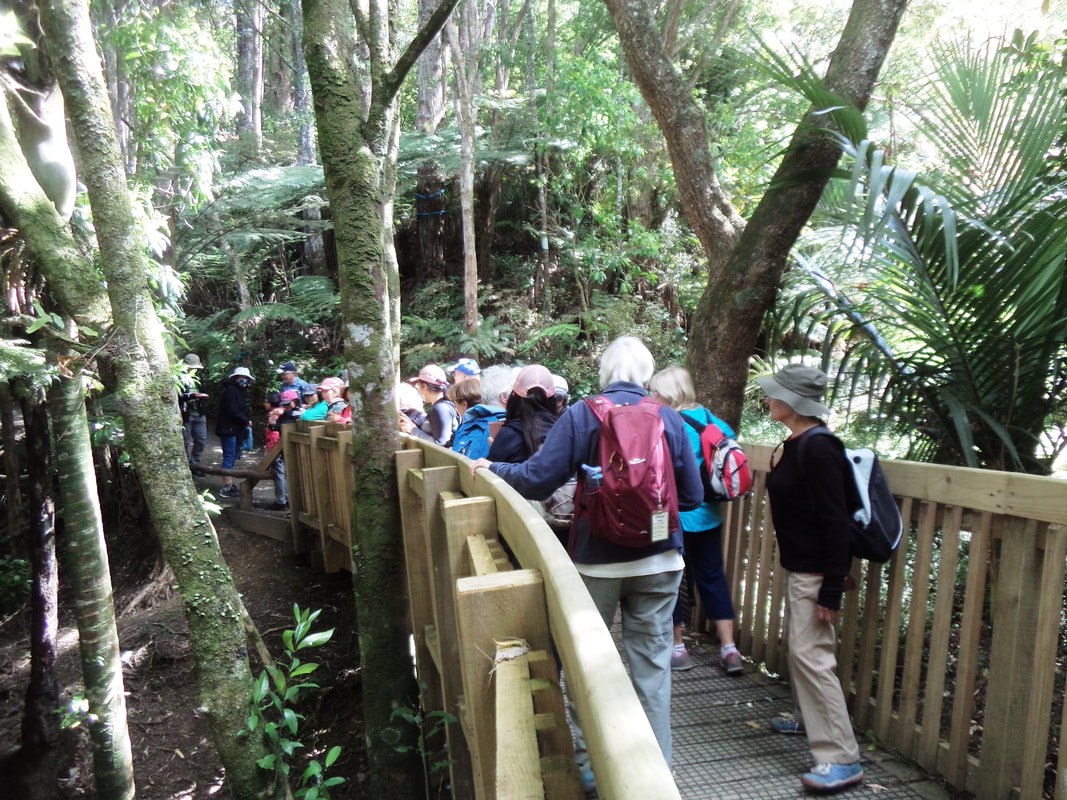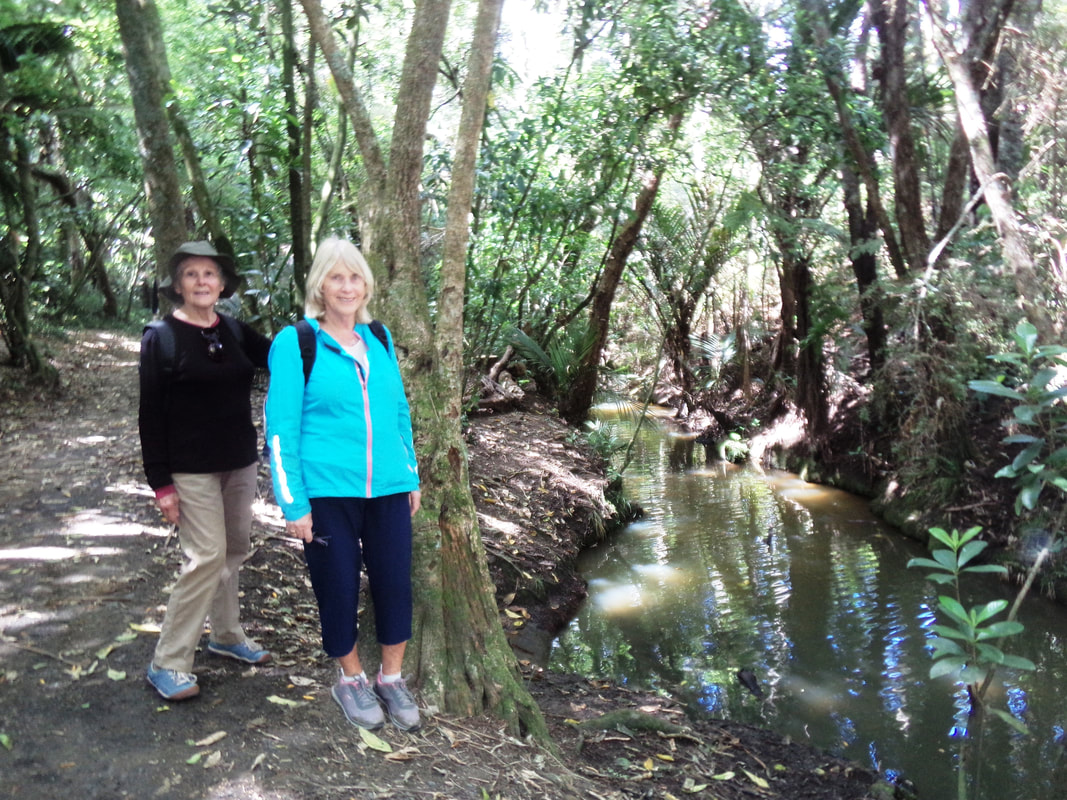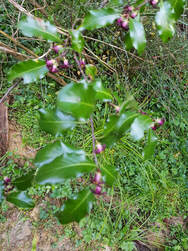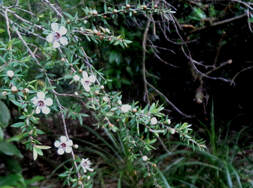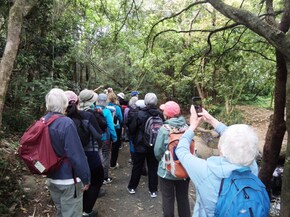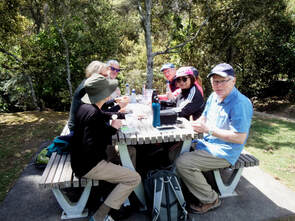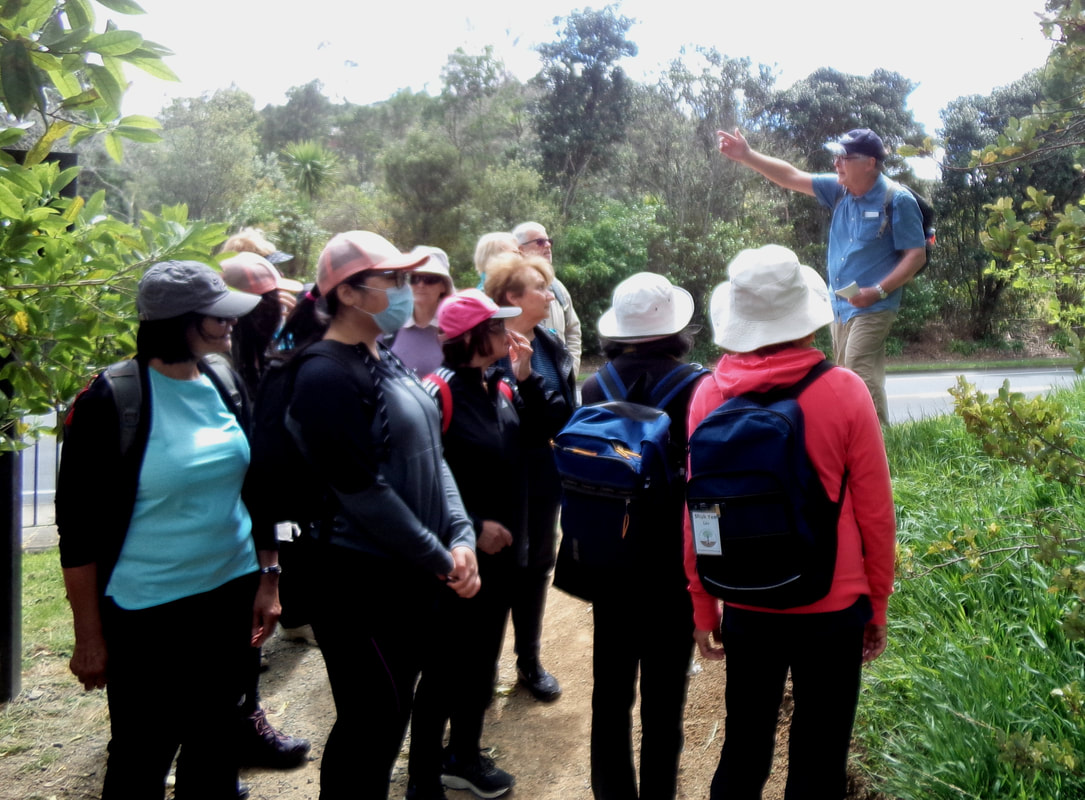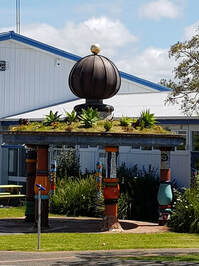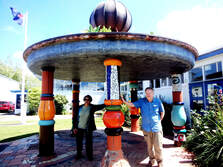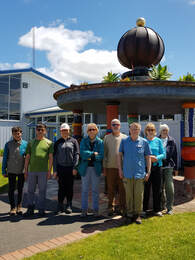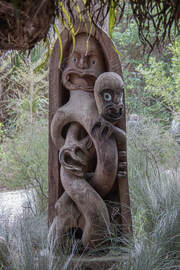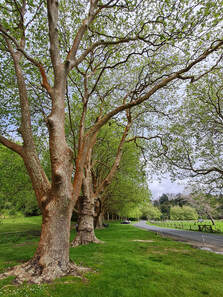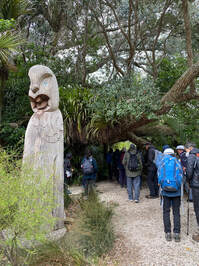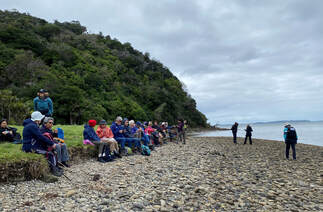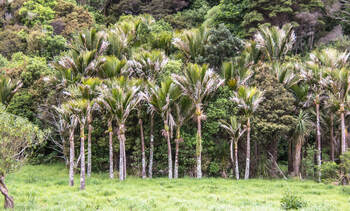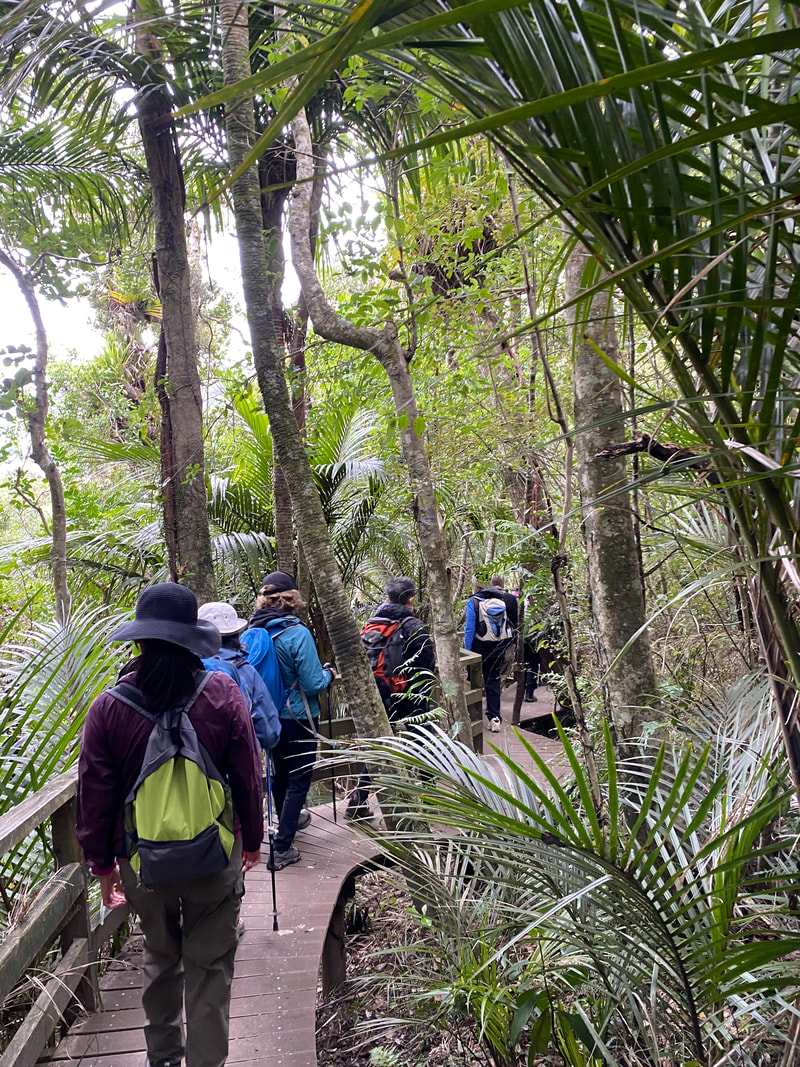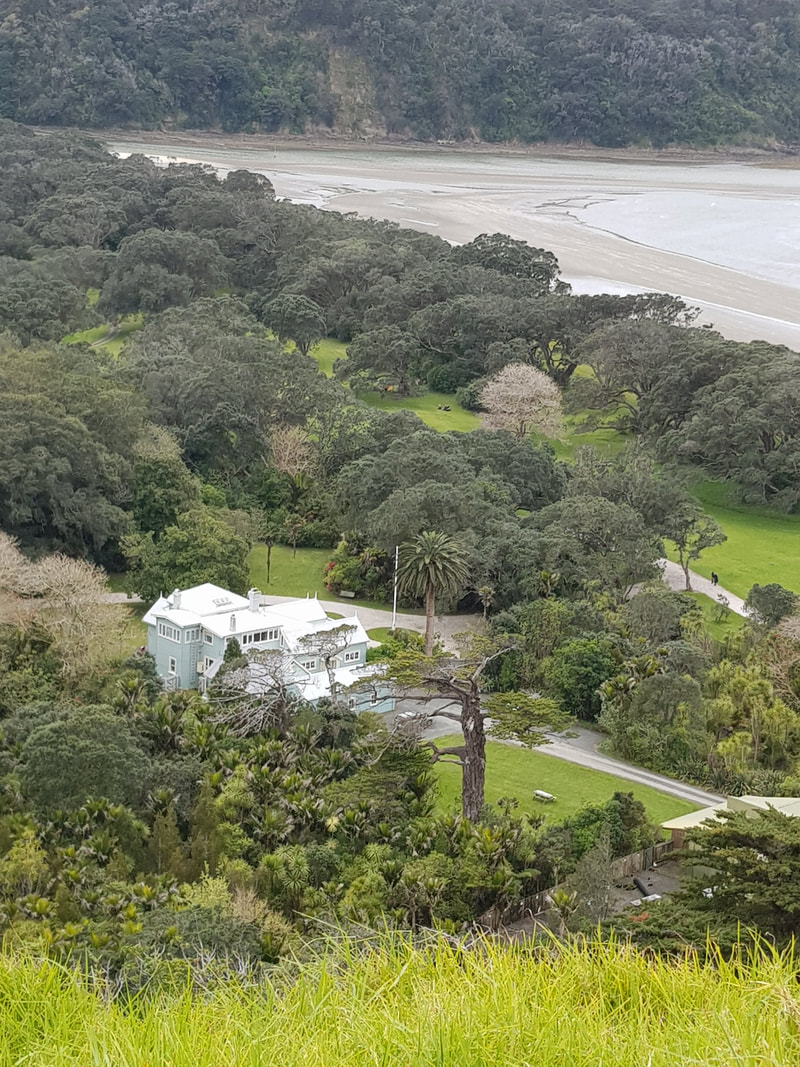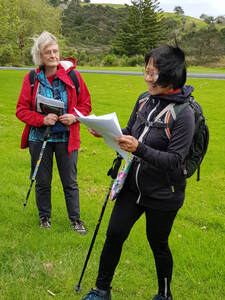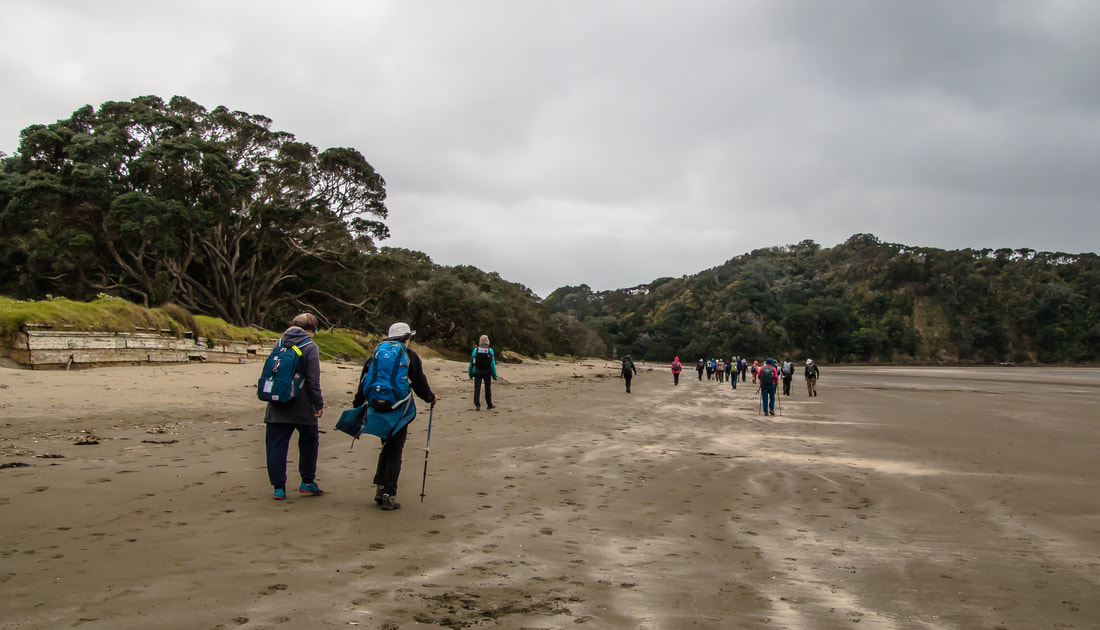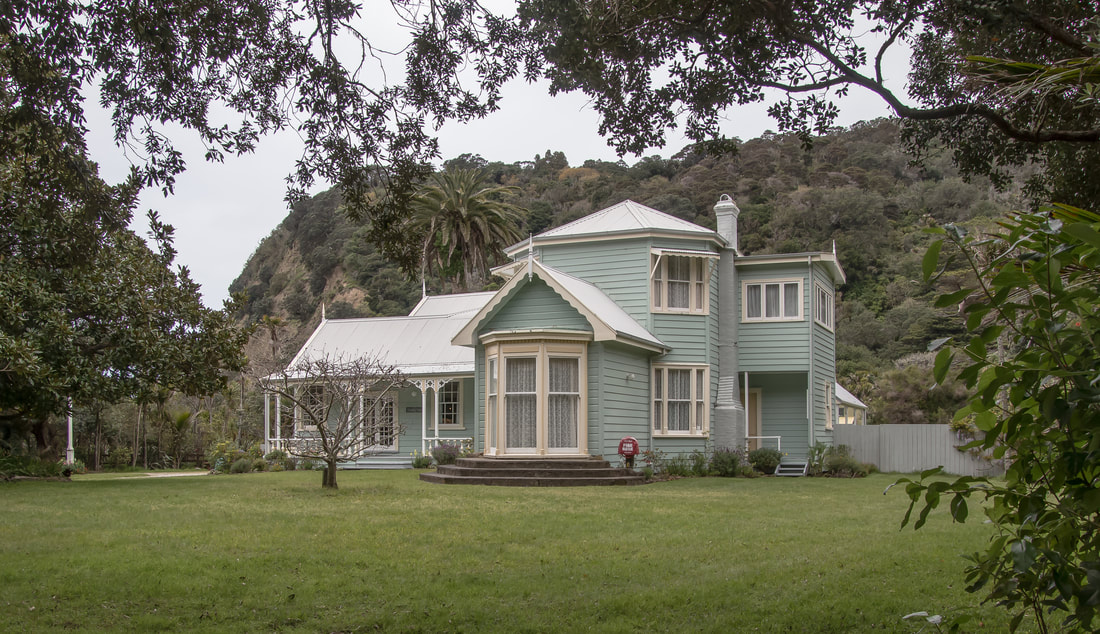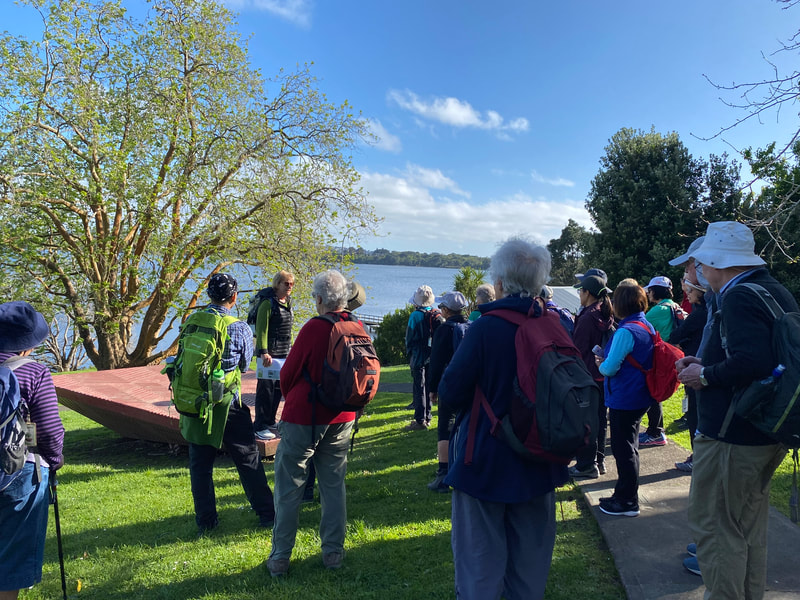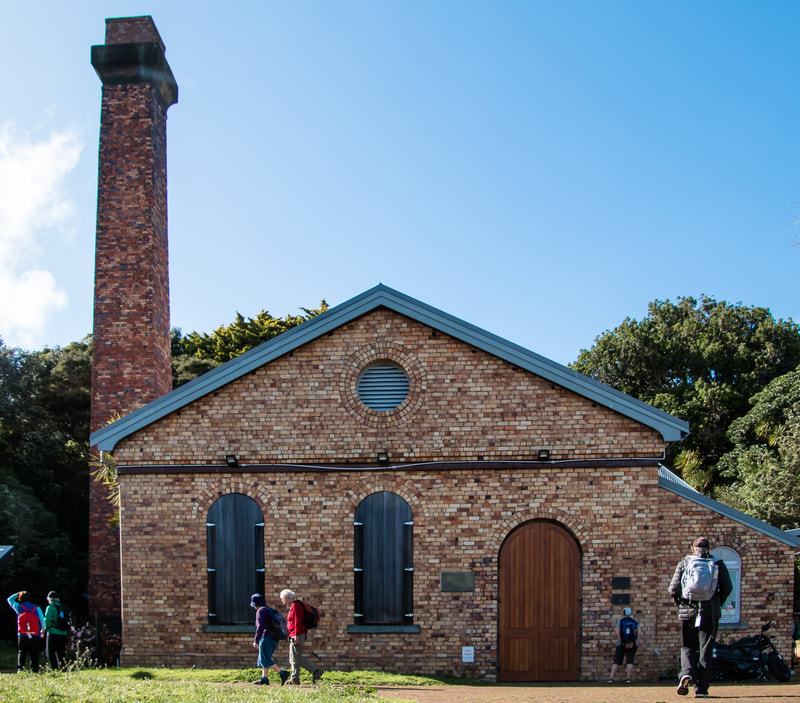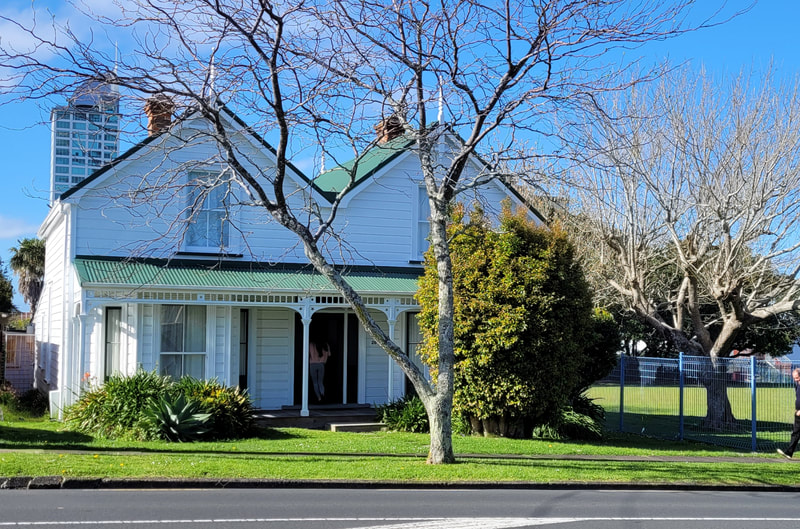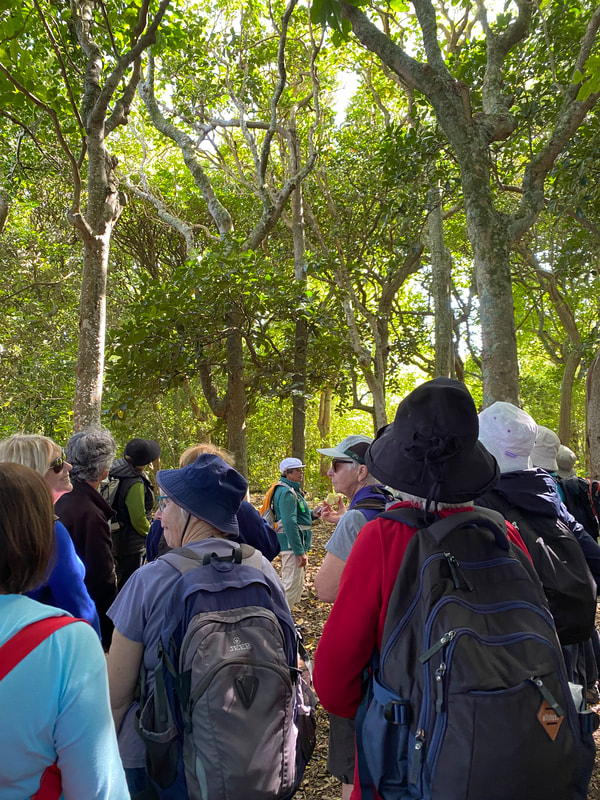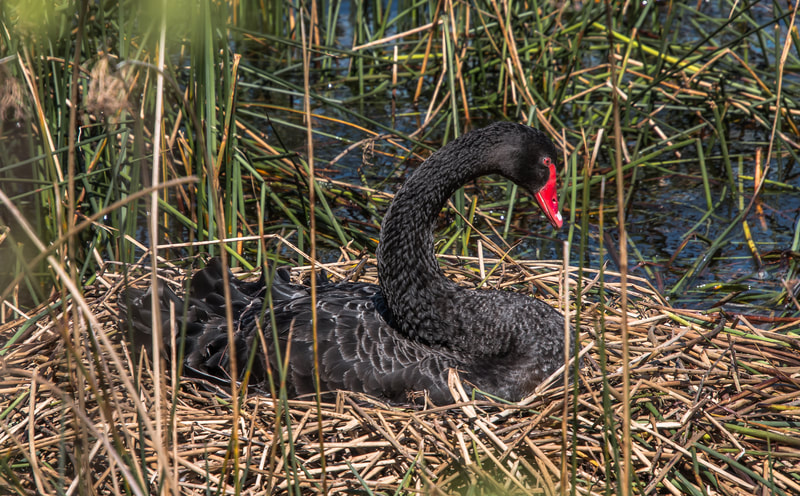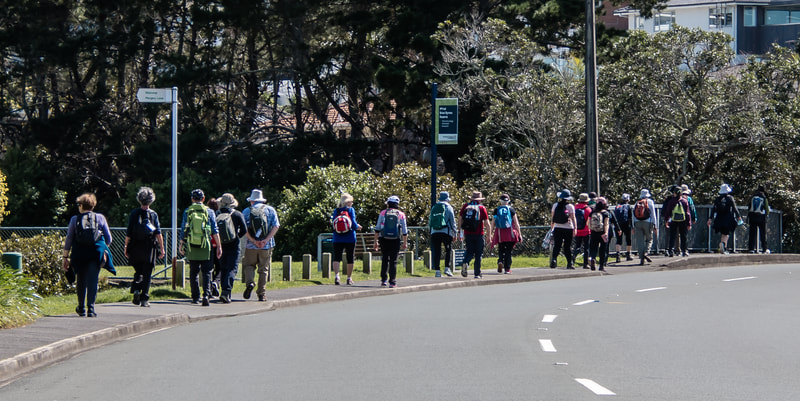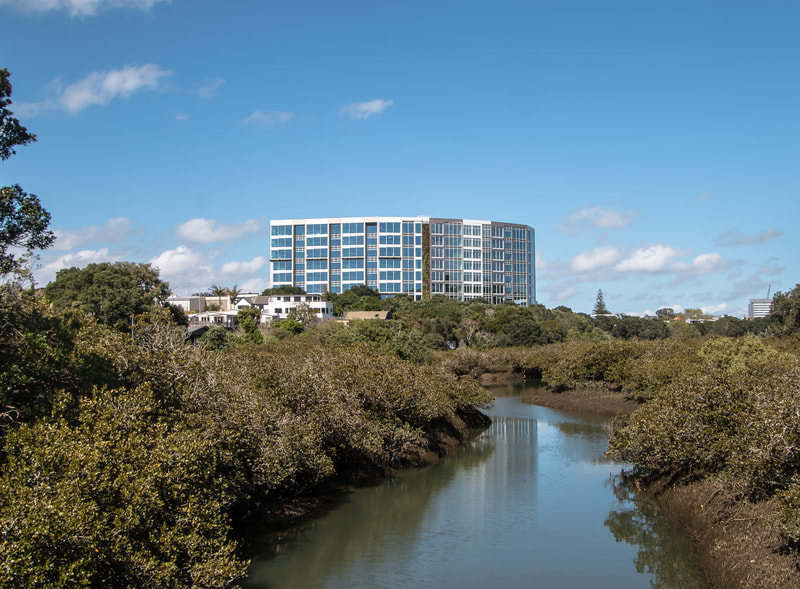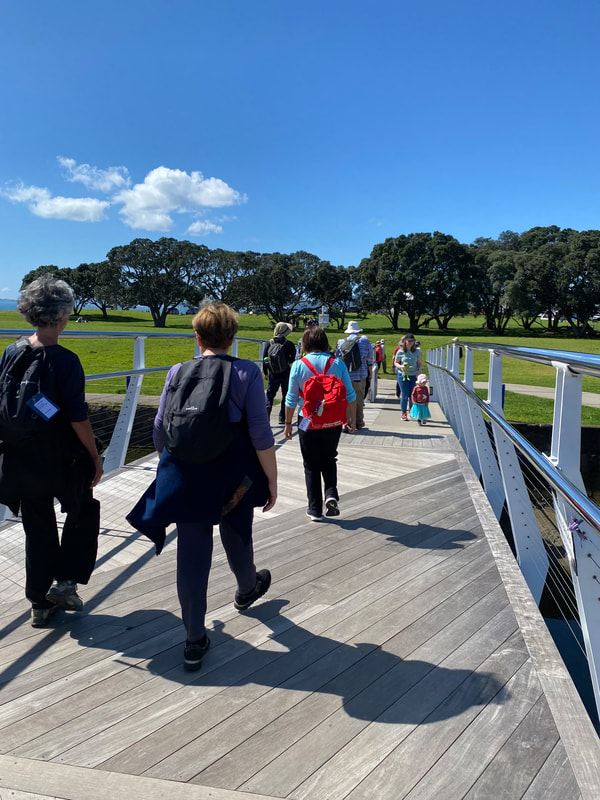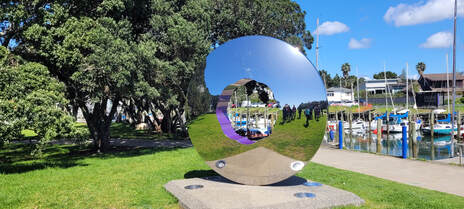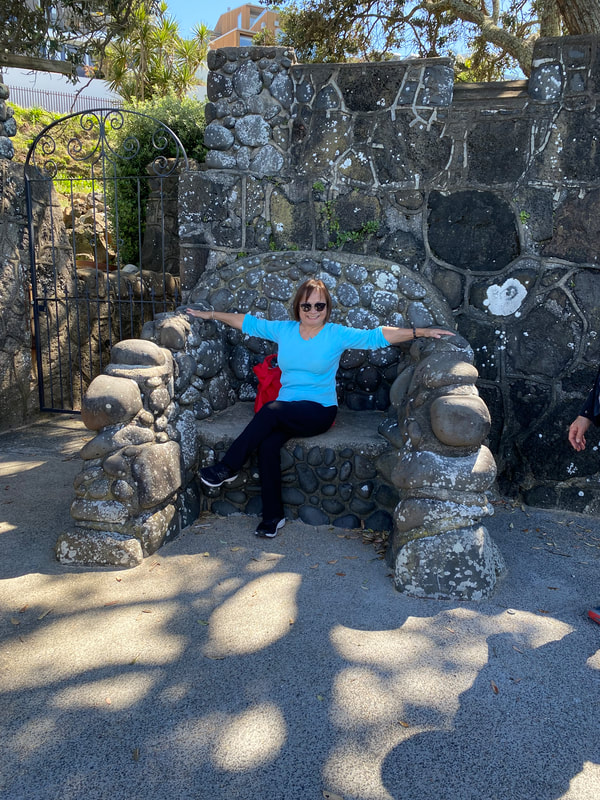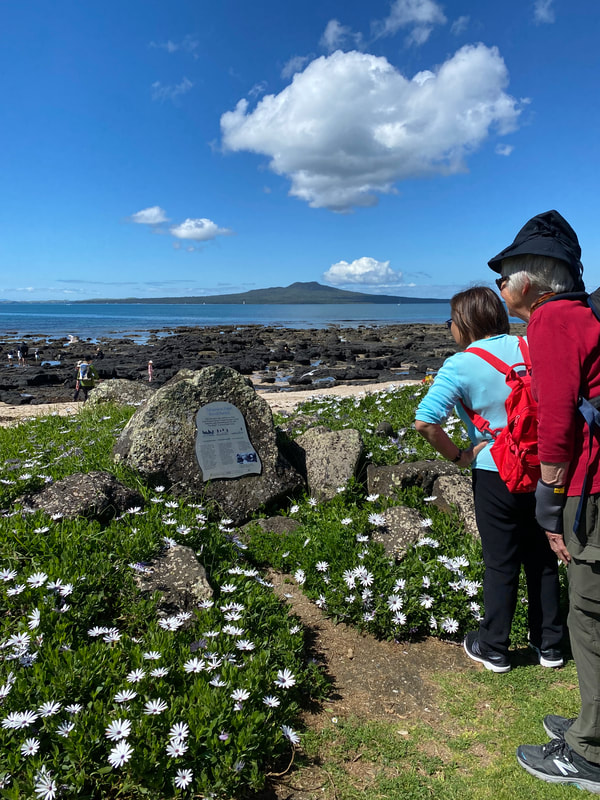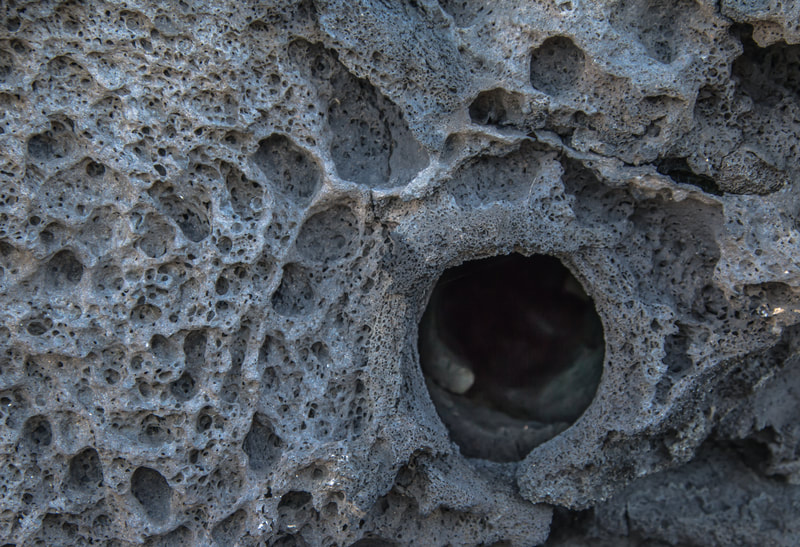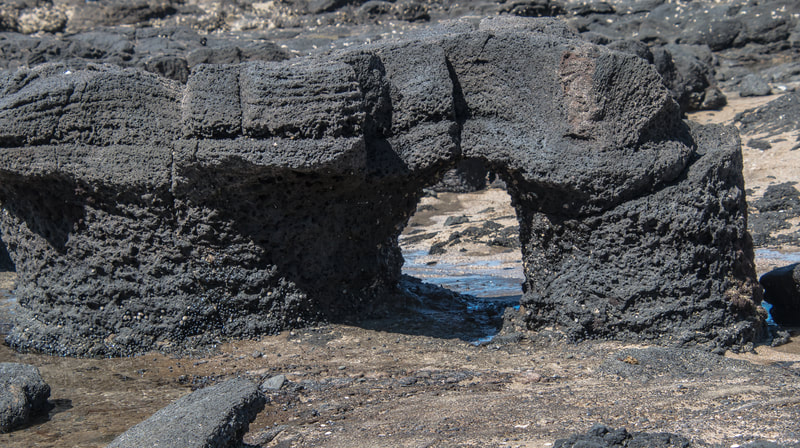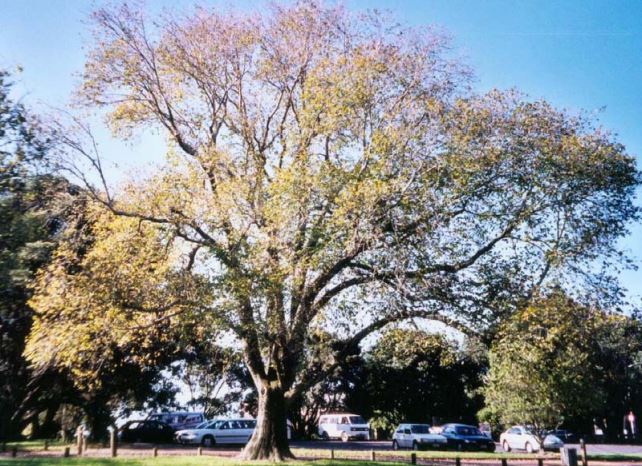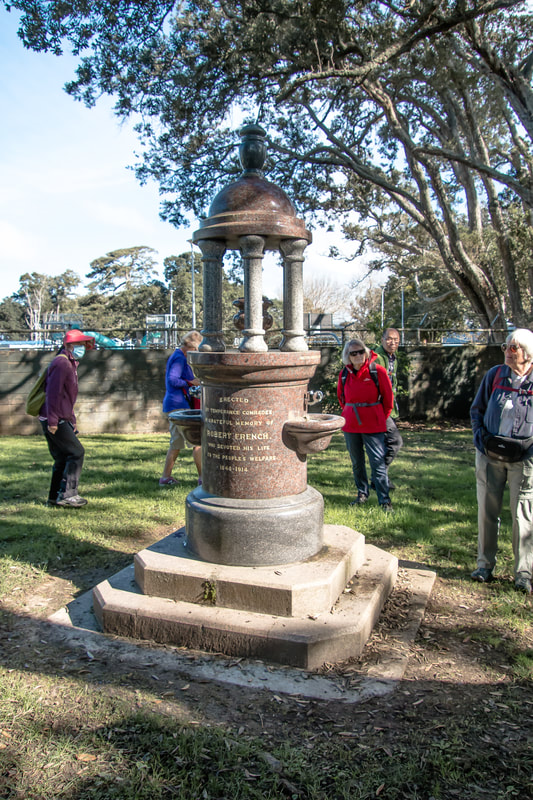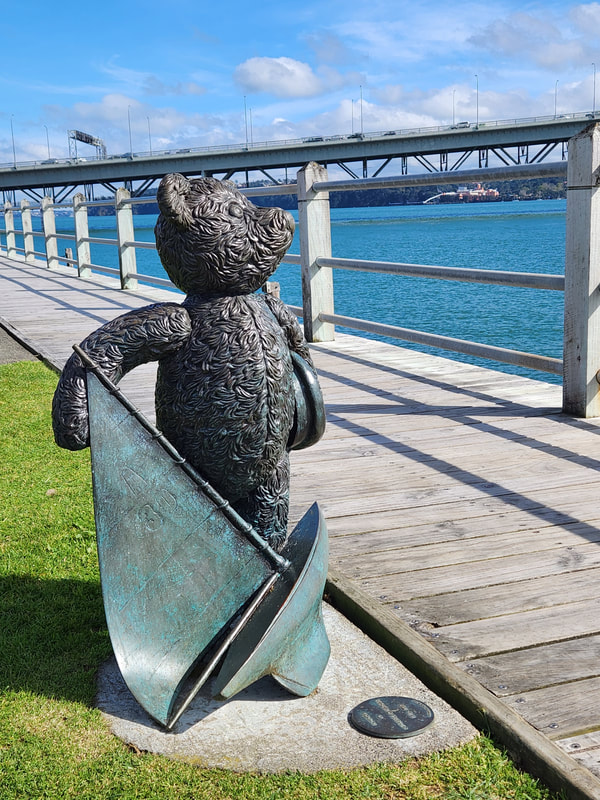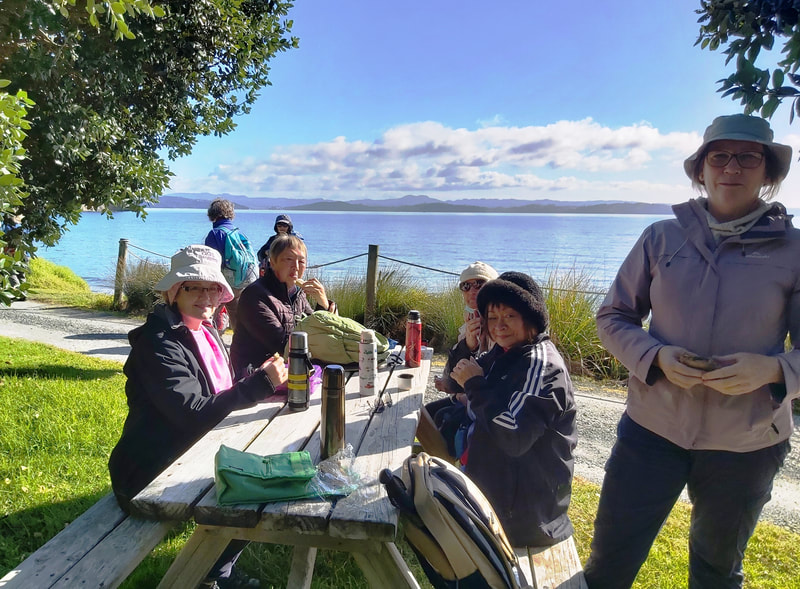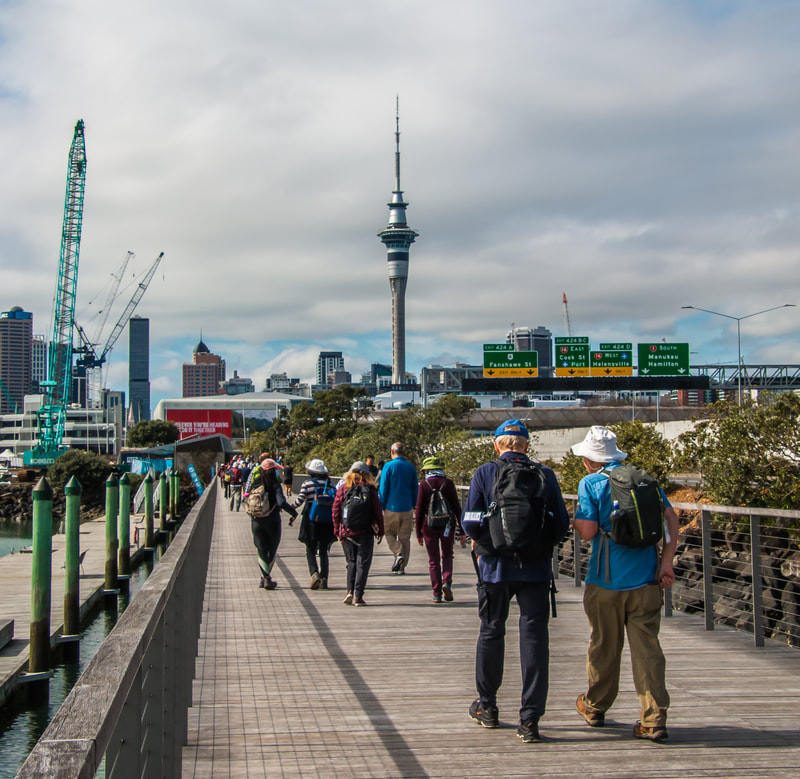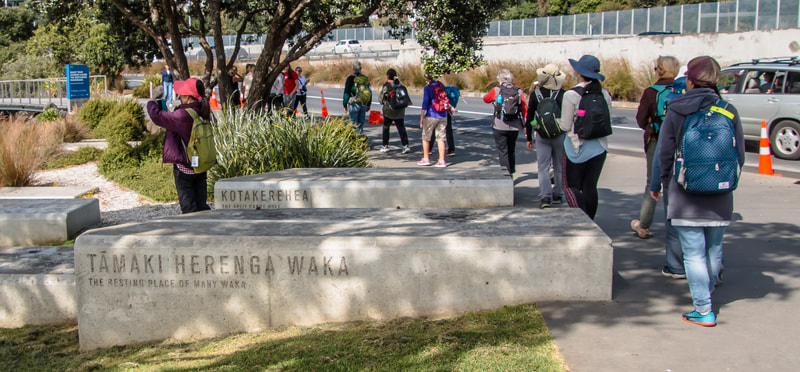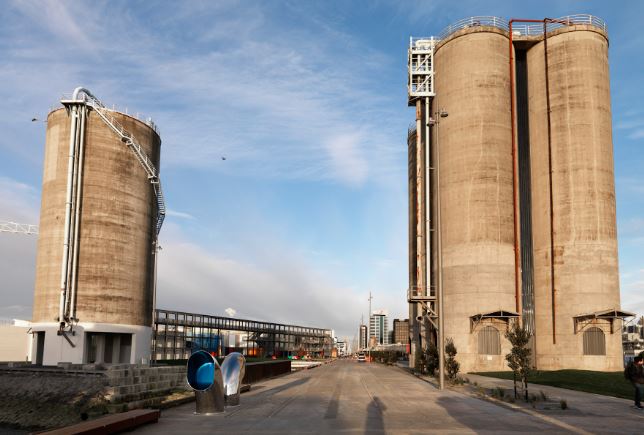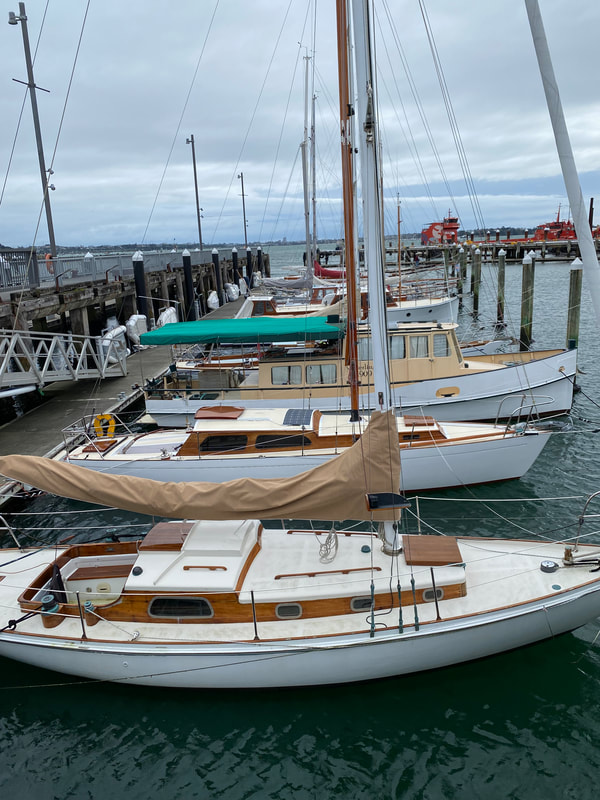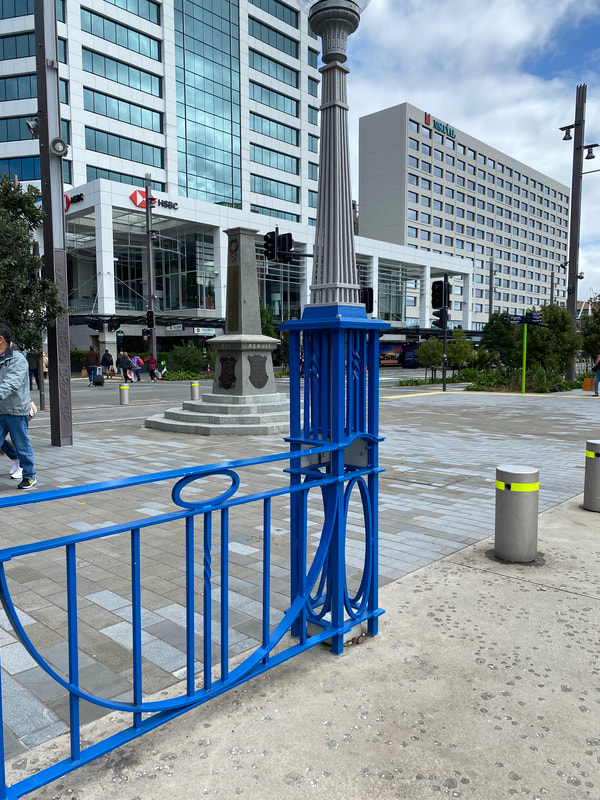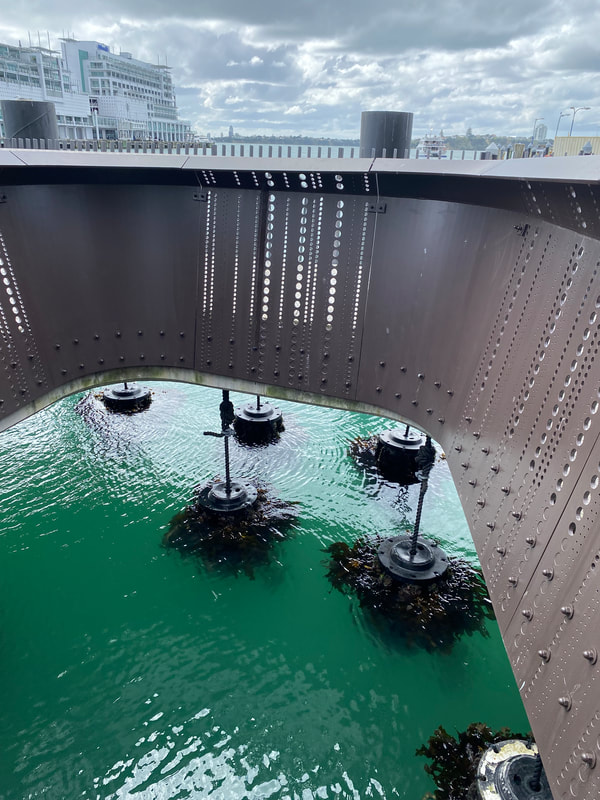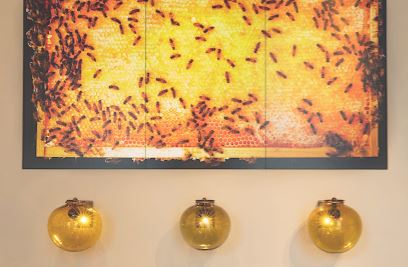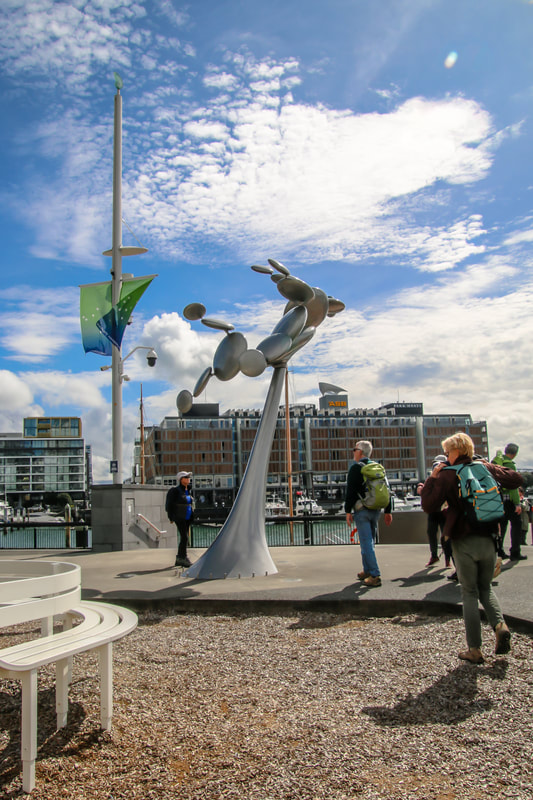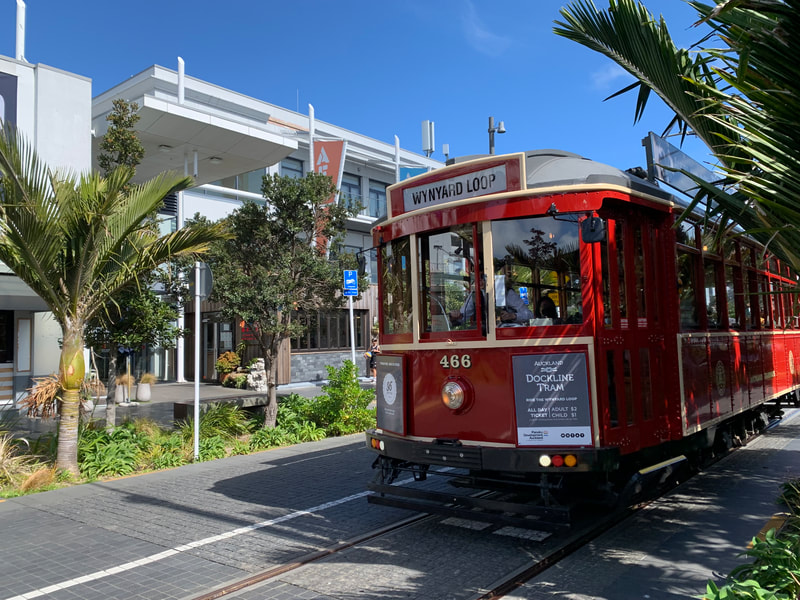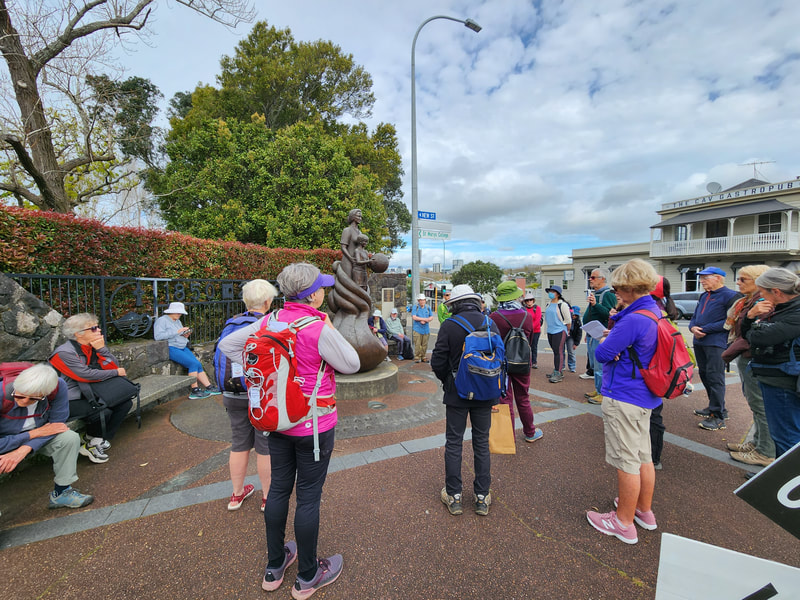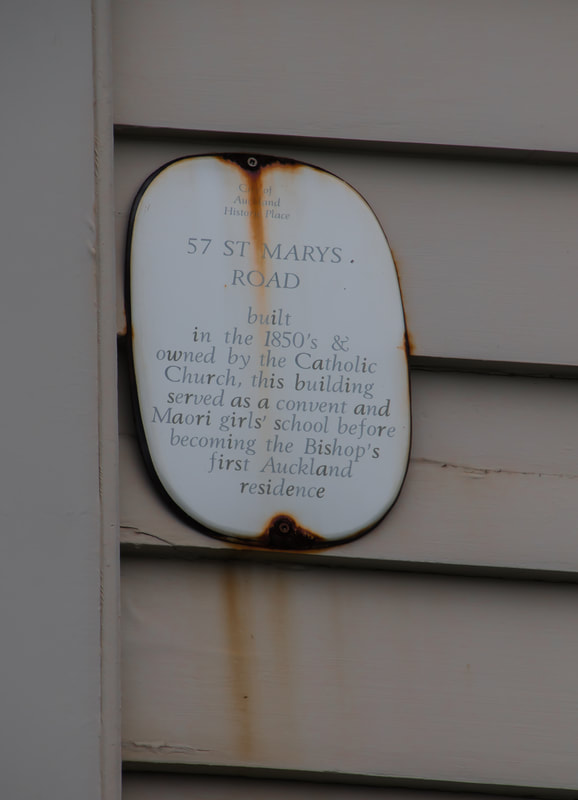Trip Reports: September-October 2022
16 October - North Shore Reserves
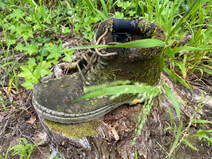 Left behind?
Left behind?
Twenty seven eager walkers gathered at the Eskdale Road entrance to the Birkenhead Domain and went through the boot cleaning station. We gathered beyond that to hear how, in May 1981, children from Beach Haven Primary School had helped to plant 120 kahikatea trees in the reserve, then weeded around them and mowed the grass until the trees were properly established.
On a previous occasion when our club had visited this area, a member had noted that about 50 different native species were present here. These included five podocarps: tanekaha, miro, matai, rimu and kahikatea and some kauri. There were also three tree fern species: ponga, mamaku and wheki. We spotted all of the above without even leaving the well-maintained track!
On a previous occasion when our club had visited this area, a member had noted that about 50 different native species were present here. These included five podocarps: tanekaha, miro, matai, rimu and kahikatea and some kauri. There were also three tree fern species: ponga, mamaku and wheki. We spotted all of the above without even leaving the well-maintained track!
This was definitely heaven for anyone interested in learning about our native trees and shrubs.
Following the loop track first, we found the small and large leaved mingimingi, many tree- daisies, several young miro plants, dracophyllums (“dragon tree”) and a large patch of kumarahou (unfortunately no longer in full bloom, as it had been on our reccies). But our most pleasing find was a large black matipo, when one of our walkers noticed many deep red flowers fallen on the track!
We took our time on this walk, there was so much to see in a small area. Back near the boot- cleaning station at the end of the loop walk, we carried on into Eskdale Reserve, then stopped for lunch. It was good that we had three picnic tables where we could sit and have lunch and a good chat.
Carrying on further, we went past the swampy area and up to Beach Haven Road, before turning back.
Gathering back at the picnic spot, we heard about our final stop for the day: Birkenhead Intermediate School has the distinction of having only the second structure in the southern hemisphere that was built to a design by the late Austrian artist, Friedensreich Hundertwasser. The first was, of course, the public toilet block in Kawakawa! The second is the entrance to the school library, with a garden growing on its roof.
The story of the building of “The Pavilion for Nature” deserves a whole book written about it: the tireless efforts made by various individuals in the school must have been quite an example for the schoolchildren. There may be no such book, but there is a photographic record in the library and on its flyleaf are the names of all the children who helped and of the adults who guided them in doing the planting on the roof and the mosaic work. They had also made a video record of the building work as it progressed!
It was a short day but seeing the library entrance was a lovely way to finish!
Special thanks to Praemi and Don for organising this lovely botanical walk.
Text: Praemi, Photos: Sue, Praemi & Linda
It was a short day but seeing the library entrance was a lovely way to finish!
Special thanks to Praemi and Don for organising this lovely botanical walk.
Text: Praemi, Photos: Sue, Praemi & Linda
09 October - Wenderholm
The destination for our walk on the 9th of October was the beautiful Wenderholm Regional Park, set between the Puhoi and Waiwera Rivers, just north of Orewa. Being rich in bird life, historic trees as well as native trees, this park promised much of interest.
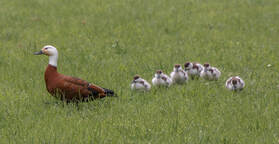
Although the sun did not shine often for our day, we delighted in seeing the obvious signs that spring had arrived. The delicate green leaves on the plane trees that line the side of the road into the park and the tiny bobbing shapes in the long grass of the ducklings and pukeko chicks, were sure signs of spring.
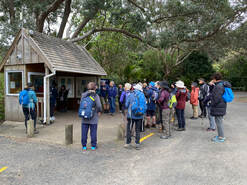
After a chat about our intended walk route and a couple of descriptions of what the park holds, our group of 35 headed for the second entrance to the Perimeter Track, having taken in the impressively carved pou whenua and some history of the area on the way which was presented on large easy to read information boards.
We paused also further along by the splendid London plane trees to listen to Cristy read out an interesting article about the trees. Once the cleaning of our footwear was completed at the specially set up station, we set off along the sturdy boardwalk through groves of nikau to our morning tea stop at Kokoru Bay. Despite it being somewhat breezy, the view over the Waiwera Estuary made it a pleasant spot for a break.
Further progress along the Perimeter Track after morning tea was not in our plan due to the bad conditions of the track, so we retraced our steps to where the Puhoi Track intersected on the right. This uphill section on the Puhoi Track called for some serious concentration so the usual chatter dropped down a level.
Some of us spied the New Zealand gloxinia in flower on the banks of the track which soon opened out onto a lovely wide swathe of grass. This gave the walkers the opportunity to reach the hilltop at a graduated pace, pausing to take in the view as they climbed.
From the summit an extensive view of the Puhoi River estuary and the park grounds could be admired. The walk down hill on the Couldrey House Track quickly brought us out onto Schischka Road having carefully negotiated the steps as we came down.
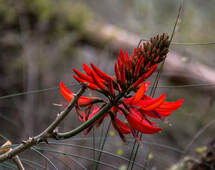 Beautiful flame tree blooms
Beautiful flame tree blooms
Now it was lunch time and any available picnic tables under the plane trees were soon taken. After a 30minute break, the next easier stage of our day started with Cristy taking the group across the road so we could walk the Schischka Camp Loop Track. A pleasant 20 minute flat walk up the access road then through the long lush grass of the camp ground, watched by some bemused campers. The estuary section of the track is edged with mangroves but unfortunately we did not see the banded rail we had read about on the bus trip earlier.
On the way to our next walk Cristy read us some information she had gathered regarding flame/coral trees.
The popular Te Akeake Walk, out to the mouth of the Puhoi River was the last walk of the day.
We strolled along the beach then moved onto the track which led to the end of the peninsula from where Mahurangi Regional Park looked so close over the dangerous waters of the narrow river mouth. The presence of a rescue life ring was noted! To complete the walk the track took us alongside the estuary, a wonderful place for sea birds to forage and then back to the car park.
Now walkers had the opportunity to visit Couldrey House, the Victorian-Edwardian family home with traditional garden. Some preferred to check out the cork tree and the park grounds before the trip back to Auckland.
It appeared most of us enjoyed a walking trip out of Auckland traveling together on the bus again.
A great day out - big thanks to Fiona and Cristy, today's leaders.
Text: Fiona
Photos: Barbara and Linda
We strolled along the beach then moved onto the track which led to the end of the peninsula from where Mahurangi Regional Park looked so close over the dangerous waters of the narrow river mouth. The presence of a rescue life ring was noted! To complete the walk the track took us alongside the estuary, a wonderful place for sea birds to forage and then back to the car park.
Now walkers had the opportunity to visit Couldrey House, the Victorian-Edwardian family home with traditional garden. Some preferred to check out the cork tree and the park grounds before the trip back to Auckland.
It appeared most of us enjoyed a walking trip out of Auckland traveling together on the bus again.
A great day out - big thanks to Fiona and Cristy, today's leaders.
Text: Fiona
Photos: Barbara and Linda
25 September - Lake Pupuke / Milford / Takapuna
On a beautiful Spring day 31 members and guests met in Killarney Park Reserve car park in Takapuna.
Walking down to Pupuke Lake we looked at a new Soapbox sculpture to commemorate the 125 year anniversary of the Suffragette movement.
Walking down to Pupuke Lake we looked at a new Soapbox sculpture to commemorate the 125 year anniversary of the Suffragette movement.
Moving down to the lake side. We were given the history of the lake which is a volcano about 150,000 years old and we heard how it is the only freshwater lake or maar in the Auckland volcanic field and served the North Shore for many years until the population expanded.
Beside the lake is the old pumping station which is now a theatre - plus, there are a French café and a small amphitheatre used in summer.
Beside the lake is the old pumping station which is now a theatre - plus, there are a French café and a small amphitheatre used in summer.
Moving on we made our way to Hurstmere Road with its many historic houses and went into Sylvan park for morning tea which is beside the lake. In here we saw the remains of a puriri forest and the park itself contains many old native trees - golden totara, karaka, kawakawa, mahoe, nikau, taraire and rewarewa. We also spotted a swan on her nest.
From the park we headed to Milford Marina and walked across the new bridge over the creek. It has a hydraulic system which lifts one side of the bridge to let the boats out to the ocean.
|
Milford Marina dates back over 150 years and was redeveloped in the 1960’s and is now a popular swimming and picnic area. We stopped to look at another new sculpture of a chrome sphere which is the shape of a donut with a hole in the middle, a beautiful object which reflects the marina and the reserve. |
This again is to commemorate the suffragette movement anniversary, the artist is Lang Ea. It has gentle violet lights that are lit from dusk to 10pm.
We had lunch and time to look around. There is a new toilet block which has large photographs from the past on the outside walls.
We set off on the last part of our journey on the Milford-Takapuna walkway along the coastline. Again, many interesting talking points along the way.
We had lunch and time to look around. There is a new toilet block which has large photographs from the past on the outside walls.
We set off on the last part of our journey on the Milford-Takapuna walkway along the coastline. Again, many interesting talking points along the way.
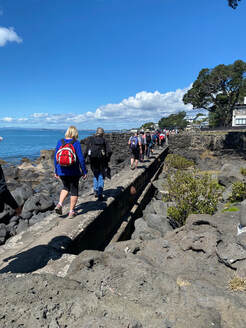
.
The group split up just before the volcanic rocks and a small group went back up onto the road and met the main group again at the other side by the camping ground in Takapuna.
Due to recent storms and the sands shifting it has exposed a 120,000 year old ancient kauri forest destroyed by the eruption and lava flow from Pupuke crater. It extends past the current shoreline and has many gas funnels showing the outline of the tree trunks.
After our ramble we headed back up the road to our cars 5 hours later.
Special thanks to our leaders - Shirley and Sandra
Great weather, great destination, great company, great leaders - a perfect day!!
Text: Shirley
Photos: Barbara, Linda and Leonie
11 September - Westhaven & City Loop Walk
32 keen walkers met at Point Erin Park this morning. It is thought to be one of the best places in Auckland to see large European elm trees planted many years ago. There are four species in the park, and Dutch elm disease, although not completely eradicated, is now contained.
We also viewed a surprise find in the park - a drinking fountain memorial, unveiled in 1917, to Mr Robert French, in recognition of his contributions to the temperance movement.
We also viewed a surprise find in the park - a drinking fountain memorial, unveiled in 1917, to Mr Robert French, in recognition of his contributions to the temperance movement.
After meandering through the park, we made our way down Curran Street, under the harbour bridge, and out onto Westhaven’s breakwater where we admired the bronze teddy bear, commissioned in memory of Lawrence D Nathan by his family (1919-1987). The captain’s hat represents “captain” of industry. The model boat is in recognition of 30 years of racing yachts and the family side explains the bear – he had a thing for teddy bears and they wanted to leave a little something whimsical. The location is a nod to his involvement, as a member of the Auckland Harbour Board, in the establishment of the Westhaven Marina (now home to over 1,800 recreational boats).
We stopped for a coffee break in front of the “mullet boats”, and then made our way around the Westhaven boardwalk, down to Silo Park and Heritage Landing.
Unfortunately, we only had time for a quick pop into the Auckland Fish Market – founded in 1904 and still managed and stocked by Sanford who prioritise sustainability and longevity in the way they fish - as some of us needed to be at the Comvita Wellness Lab by noon.
The 100 metre long, Te Wero Bridge (modern double bascule, built in 2011), slowed us down a little, as it opened as we approached. Having said that, it was great to see it operating.
Noelani, beekeeper with Comvita, had kindly agreed to speak to us, but because of space we needed to split into two groups. Half of us headed to the new waterfront redevelopment (adjacent to the Ferry Building) for lunch, while the other half stopped at Comvita’s Wellness Lab on Quay Street.
The $350 million redevelopment, a 30 metre extension, with apertures to see down to the sea below, and large, fully mature Pohutukawa trees in planters, was an ideal lunch stop – plenty of seating plus interesting aspects of the development to admire, including the Auckland Harbour Board blue fences and war memorial reinstated, paving using shells from the harbour set in the concrete, a woven net suspended in one of the openings above the water, and 38 seeded mussel lines hanging under the extension that will in time do their bit to improve our water quality.
The 100 metre long, Te Wero Bridge (modern double bascule, built in 2011), slowed us down a little, as it opened as we approached. Having said that, it was great to see it operating.
Noelani, beekeeper with Comvita, had kindly agreed to speak to us, but because of space we needed to split into two groups. Half of us headed to the new waterfront redevelopment (adjacent to the Ferry Building) for lunch, while the other half stopped at Comvita’s Wellness Lab on Quay Street.
The $350 million redevelopment, a 30 metre extension, with apertures to see down to the sea below, and large, fully mature Pohutukawa trees in planters, was an ideal lunch stop – plenty of seating plus interesting aspects of the development to admire, including the Auckland Harbour Board blue fences and war memorial reinstated, paving using shells from the harbour set in the concrete, a woven net suspended in one of the openings above the water, and 38 seeded mussel lines hanging under the extension that will in time do their bit to improve our water quality.
The half hour that each group spent with Comvita was hugely informative. Noelani, with her extensive experience as a beekeeper, educator and consultant held the groups’ interest with all the facts and stories that she relayed, the questions she answered, and the rewarewa and manuka honey samples that she offered us to smell and taste!
From this point, John took over as leader. We headed up Albert Street to the corner of Customs Street where John pointed out Auckland’s old Customhouse. John explained that the Customs Department originally occupied the ground floor with a variety of other government departments on the higher floors. The building opened in 1889 and is now registered by the New Zealand Historic Places Trust as Category One.
Our next historic stop – the Tepid Baths! Built in 1914, they offered 12 sipper baths with a choice of hot or cold, fresh or salt water. They were so popular with people living in the city (without their own baths), in the 1930’s their number was increased. They also provided two heated saltwater pools.
We saw many pieces of art on this walk, and as we made our way around the Viaduct Marina we came across long modified benches by Danish artist Jeppe Hein. Also, Cytoplasm a dancing kinetic sculpture by Phil Price – a large, wind-activated artwork made up of 16 pod-like discs, which move on their own and together. Even in a gentle breeze Cytoplasm is constantly in motion, much like the work’s namesake: cytoplasm is the gel-like substance within living cells that carries out life’s processes and gives cells their pod-like form.
It was great to see the Wynyard Loop tram back in action too!
From this point, John took over as leader. We headed up Albert Street to the corner of Customs Street where John pointed out Auckland’s old Customhouse. John explained that the Customs Department originally occupied the ground floor with a variety of other government departments on the higher floors. The building opened in 1889 and is now registered by the New Zealand Historic Places Trust as Category One.
Our next historic stop – the Tepid Baths! Built in 1914, they offered 12 sipper baths with a choice of hot or cold, fresh or salt water. They were so popular with people living in the city (without their own baths), in the 1930’s their number was increased. They also provided two heated saltwater pools.
We saw many pieces of art on this walk, and as we made our way around the Viaduct Marina we came across long modified benches by Danish artist Jeppe Hein. Also, Cytoplasm a dancing kinetic sculpture by Phil Price – a large, wind-activated artwork made up of 16 pod-like discs, which move on their own and together. Even in a gentle breeze Cytoplasm is constantly in motion, much like the work’s namesake: cytoplasm is the gel-like substance within living cells that carries out life’s processes and gives cells their pod-like form.
It was great to see the Wynyard Loop tram back in action too!
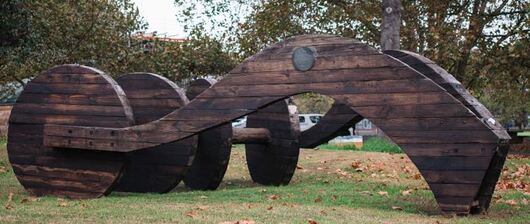 Homage to Will - made by American artist, Fred Loopstra.
Homage to Will - made by American artist, Fred Loopstra.
Victoria Park was our next destination – wide open playing fields, surrounded by London plane trees, many showing the first signs of spring growth. We passed one lonely, abandoned beehive (Noelani advised it is about to be replaced with two active hives), an adjacent garden and two large compost boxes, part of the initiative to grow bee forage. A few metres from this was a large wooden sculpture,inspired by old abandoned agricultural equipment, and made from sleepers provided by NZ Railways.
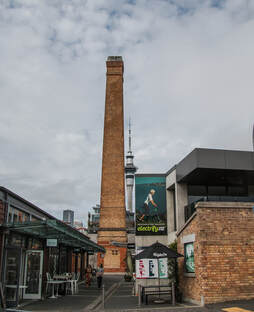 Victoria Park Market - 38m chimney, the "Destructor".
Victoria Park Market - 38m chimney, the "Destructor".
Victoria Park Market - between 1905 and 1918, a series of brickwork buildings were constructed on the site, initially to deal with the disposal of rubbish from the city – including the 38m tall chimney. Further additions were made late in this period, including double storeyed stabling for the 94 horses used to pull the city’s rubbish carts, with a ramp that took the horses up to the 2nd level of the stables.
In the early 1980’s, the Council planned to demolish the complex, but relented following a public campaign. It was subsequently converted into a very popular market and retail complex. Many of us have memories of visiting Victoria Park Market when it was a thriving hub and visitors from out of town always wanted us to take them there.
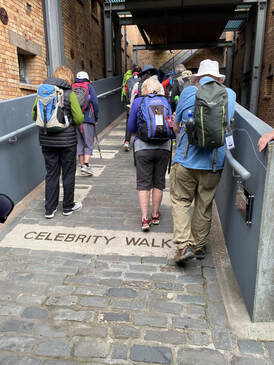
We discovered that Victoria Market is now very quiet - providing offices and studios to small businesses with only a couple of restaurants and bars.
We did wander up the ramp that took the horses to the 2nd level of the stables – it had been transformed into a “Celebrity Walk”. An opportunity to reminisce about the many famous, or at least well known, New Zealanders whose hand or foot prints were set into the ramp. The complex has now been awarded a Category 1 Historic Places classification.
Gillian now assumed leadership and when we reached the junction of College Hill and New Street, Gillian explained that the statue there depicts a Maori woman and child stepping from the waves and recalls the request from Maori women to Bishop Pompallier to bring with him, on his return to New Zealand in 1850, “wahine tapu” (sacred women) to teach their children. These women were Sisters of Mercy, the first order of Irish “walking nuns” – so called because they walked out into the community to visit the poor, the sick and the uneducated.
In 1859, New Street was formed and 18 acres along its southern side were formally handed over by Bishop Pompallier to the Sisters of Mercy. In 1861, the foundation brick was laid for a large convent building named St Mary’s. By 1864, a school, St Mary’s College, had been added to the convent complex (replacing the original Maori girls’ school). In 1865, Old Saint Mary’s Convent Chapel was built in the Gothic Revival Style and is Heritage category level 1.
Sister Mary Leo was, for many years, a music teacher at the college and trained a number of singers, including Dame Kiri te Kanawa, Inia te Wiata and Dame Malvina Major.
On the opposite side of New Street, we saw The Pompallier Diocesan Centre and Bishop’s Palace (designed by Peter Paul Pugin and built in 1894 by successors of Bishop Pompallier).
Pompallier’s original house (Heritage category 1), was moved from this site in 1893 to 57 St Mary’s Bay Road.
In 1859, New Street was formed and 18 acres along its southern side were formally handed over by Bishop Pompallier to the Sisters of Mercy. In 1861, the foundation brick was laid for a large convent building named St Mary’s. By 1864, a school, St Mary’s College, had been added to the convent complex (replacing the original Maori girls’ school). In 1865, Old Saint Mary’s Convent Chapel was built in the Gothic Revival Style and is Heritage category level 1.
Sister Mary Leo was, for many years, a music teacher at the college and trained a number of singers, including Dame Kiri te Kanawa, Inia te Wiata and Dame Malvina Major.
On the opposite side of New Street, we saw The Pompallier Diocesan Centre and Bishop’s Palace (designed by Peter Paul Pugin and built in 1894 by successors of Bishop Pompallier).
Pompallier’s original house (Heritage category 1), was moved from this site in 1893 to 57 St Mary’s Bay Road.
Jean-Baptiste Francois Pompallier, was the first vicar apostolic of Western Oceania. Pompallier set out from France with other missionaries in 1838, learning te reo Maori on the journey. They set up a printing press to produce material in te reo Maori, English and French on arrival. A number of missions were set up and Pompallier had tremendous mana with Maori and their chiefs. He declined to give advice prior to the signing of the Treaty of Waitangi, saying he could only advise them on spiritual matters.
In the 1860’s, Pompallier was made the first Catholic Bishop of Auckland. Unfortunately, this was the time of the Land Wars and the Maori quietly went back to their hapu. Money fell short and the situation was dire by the time Pompallier returned to France in 1868. He died near Paris in 1871.
130 years after his death, Pompallier’s bones were exhumed and brought “home” to the Hokianga. A carved, Maori casket was specially made, and it was carried all around NZ, never being out of human contact. He now rests in a chapel at Motuti.
After admiring Pompallier’s original house in its new location, we continued our journey down to St Mary’s Bay Reserve, turned north along the edge of the motorway and up the steps back to our cars at Point Erin Park.
In the 1860’s, Pompallier was made the first Catholic Bishop of Auckland. Unfortunately, this was the time of the Land Wars and the Maori quietly went back to their hapu. Money fell short and the situation was dire by the time Pompallier returned to France in 1868. He died near Paris in 1871.
130 years after his death, Pompallier’s bones were exhumed and brought “home” to the Hokianga. A carved, Maori casket was specially made, and it was carried all around NZ, never being out of human contact. He now rests in a chapel at Motuti.
After admiring Pompallier’s original house in its new location, we continued our journey down to St Mary’s Bay Reserve, turned north along the edge of the motorway and up the steps back to our cars at Point Erin Park.
Thanks to John, Gillian and Linda for putting together this nautical and historical day.
Text: Linda
Photos: Tina, Robyn and Barbara.
Text: Linda
Photos: Tina, Robyn and Barbara.

